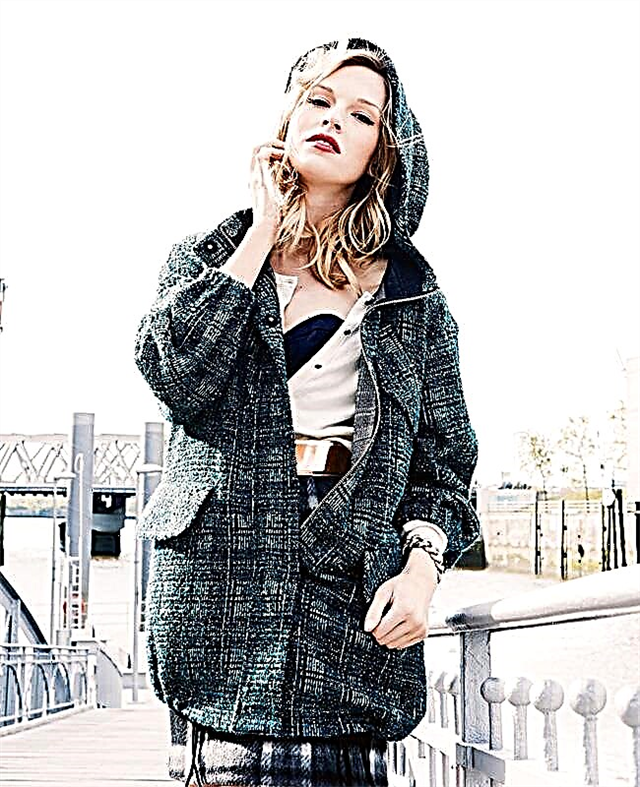A brief history of jeans in 15 curious facts about them.
As part of our new Theme of the month, dedicated to the style of Western, we offer you to plunge with us into the fascinating history of jeans!
1. The first jeans were brown

Miners in jeans, 1882
The appearance of jeans accompanies many legends. Here is one of the main versions. In the late 1840s, California began to mine gold. In 1853, a 24-year-old Levi Strauss arrived from Europe with a ship loaded with various haberdashery, including a thick brown cloth for tents and tents. He successfully sold haberdashery, but he did not trade in fabrics. Then Strauss ordered to sew pants from her - they quickly sold out. An enterprising young man acquired more fabrics, launched the production of pants and soon opened a store for their sale. Thus, the first jeans were brown in color, very tight and looked more like overalls. By the way, they already had a double line, making the seams stronger.
How to wear jeans this fall: 17 looks
2. Where did the word “jeans” come from?

The name "jeans" was firmly entrenched in this clothing only in the 1960s.
The word "jeans", written in Cyrillic, comes from the English "jeans". According to one version, this "jeans" was formed from "Genes", which means "Genoa". It was from there that the fabric was sent for the first jeans, which Levi Strauss brought to America. Stamps "Genes" stood on bales with fabric - hence the name came from. The second version: as early as the 16th century, the cotton diagonal weave twill jean, a special kind of Genoese bumasei, was known in Europe. Then clothes from such fabric were worn by Genoese sailors. From the Italian "gene" in Old French, the word "jane" appeared and from there it switched to English. In general, the name "jeans" was firmly entrenched in this clothing only in the 1960s, and before that, jeans were often called "overalls".
Jeans - a unique uniform
3. And what does the word denim mean?

Classic denim - indigo colors, a shade between blue and purple
The word "denim" originally meant "de Nimes" - "from Nimes." This refers to the French city of Nimes, where Levy Strauss subsequently ordered fabric for his production of pants. This fabric was quite strong, twill weave, dyed indigo. Today denim is called dense twill weave, in which only the warp thread, but not the weft, is traditionally dyed. The twill weave is such that the warp threads are more visible on the front side of the fabric, so the denim is more saturated on the outside than on the inside.
The history of the mannequin: from a wooden idol to an art object
4. Parents of jeans fashion - not cowboys

Levi Strauss Cowboy Advertisement
Contrary to popular belief, not cowboys were the first to dress in jeans, but miners and gold miners. It was to these hard workers that Levi Strauss sold the first samples of what has now become the most popular clothing in the world, jeans. Cowboys originally wore thick leather pants. They first put on jeans at the beginning of the twentieth century, during the spread of the rodeo. Subsequently, cinema and ... Levi Strauss advertising promoted the consolidation of the romantic image of a cowboy in indispensable jeans, hat and shirt. In the 1930s and 1940s, a fashion appeared in the United States to relax on a ranch, while vacationers wanted to feel like a western hero. Then the cowboy became a symbol of Levi's advertising campaigns.
The history of fashion shows and Fashion Weeks: from private shows to grand shows
5. Rivets on jeans - not just for beauty

The idea of rivets is borrowed from horse harness
Metal rivets appeared on jeans not as decor, but as a technical necessity. They thought of putting them on pockets at the back and front, plus - on the fly, to make the pants stronger. The idea was taken from rivets on a horse harness and implemented in the early 1870s. Subsequently, rivets from the fly and from the back pockets were removed for reasons of safety and convenience.Only those that hold the front pockets in place are left.
How to make DIY scuffs on jeans
6. The official birthday of jeans - May 20, 1873

Label Levi Strauss
It was on this day that Levi Strauss received a patent for the production of "work straps with pockets for knives, money and watches." This date can also be seen on the label (by the way, they began to sew it on jeans in 1886). Pay attention to the picture: the horses are stretching a pair of jeans. It is designed to clearly demonstrate the strength of the pants.
What to make of old jeans: 19 great ideas
7. Jeans would not be jeans without movies and music

Western star Tom Mix in jeans in the movie Indomitable (1920)

Elvis Presley in the movie Prison Rock (1957)
It is difficult to overestimate the role of cinema in the formation of fashion trends of the last century. Jeans fashion was also largely initiated by him. Courageous beauties in films about the Wild West of 1920-30s, movie idols of the 1950s Marlon Brando and James Dean - they all wore jeans. Elvis Presley's jeans were especially popular, appearing in them in the musical film Prison Rock (1957). The real cult of jeans was made by rock music in the 1960-1970s. Jeans have become a symbol of protest, rebellion, a way to stand out from the crowd. However, they were not recommended to go to work or a decent restaurant at that time - it was considered bad form.
8. Jeans: war and peace

For hippies, jeans became almost uniform
During World War II, jeans became almost the uniform of the US military (in these years, jeans in America were made and sold only for combatants). This did not stop jeans after the war, in the 1960-1970s, from becoming the same uniform for hippies calling for peace and love.
9. Women dressed in denim a little later than men

Levi's clothing advertisement for women, 1918

Levi's Women's Jeans Advertisement 1960s
Officially, the first pair of Levi's jeans for women was released in 1934. But researchers claim that women wore jeans in the 1920s - it was comfortable to work and relax. True, women's jeans became truly fashionable several decades later.
10. Fashion for women's jeans asked Marilyn Monroe

Marilyn has proven that jeans can be feminine
Marilyn Monroe is considered one of the forefathers of jeans fashion in a women's wardrobe. She demonstrated their attractiveness in several of her early photo shoots, and then starred in the films The Misfits, The River With No Return, and The Night Scramble, proving that jeans can be very feminine.
11. Jeans hit the USSR in 1957

In the Union, jeans cost 100 rubles or more with an average salary of 120 rubles
Jeans were brought to the Soviet Union by foreign tourists and students who arrived at the Festival of Youth and Students in 1957. For a long time in the USSR, jeans were considered, on the one hand, a capitalist threat, and on the other, the quintessence of fashion and bohemianism. In the 1980s, the USSR began to produce their own jeans, but then they could not compare with foreign counterparts. To improve the "presentation" jeans were cooked - naturally, boiling in a bleach solution.
12. Designer jeans came up with Calvin Klein

15-year-old Brooke Shields in Calvin Klein commercials
In 1978, Calvin Klein became the first designer to launch his own line of jeanswear. A couple of years later, the famous movie was shot, where 15-year-old Brooke Shields says: "Do you want to know what is between me and my Calvin Klein jeans? Nothing!". The jeans model from this advertisement, indeed, could hardly accommodate at least something. Evidence says that these jeans were so narrow that sofas were put in the fitting rooms of the brand so that shoppers could squeeze into half-lying trousers. However, an advertisement with Brooke Shields caused a scandal, as a result of which Calvin Klein removed the jeans from production. The brand returned the jeans ruler only after 18 years. Meanwhile, in the 80s, Ralph Lauren, Guess, Versace and other brands launched their jeans lines.
13. Natural indigo today is a rarity

It’s harder to work with natural indigo than with artificial
Initially, denim yarns were dyed with a natural indigo dye, obtained from the indigofer plant, whose homeland is India. But in 1866, an artificial indigo substitute from nitrobenzenedehyde and acetone was invented. The new indigo was called "pure", pure indigo - natural indigo was difficult to remove from impurities, and this one was free from them initially. Getting pure indigo made denim production cheaper and easier. Denim dyed with natural indigo can be found now, but these are exclusive parties or pieces. They are often painted by hand, and they cost much more than regular jeans.
14. The oldest surviving pair of jeans - almost 140 years

The oldest jeans in the world
These jeans were sewn in 1879, found in an abandoned mine in 1998, and are now stored in a special fireproof safe in the office of Levi Strauss & Co. Experts estimate them at 150 thousand dollars (but they are unlikely to be sold).
15. The creator of jeans never put them on

Strauss preferred costumes
Allegedly, jeans maker Levy Strauss never wore jeans. During his lifetime, this clothing was considered primarily working, and Levy himself, as a prosperous industrialist, preferred classic costumes.
MORE INTERESTING ARTICLES, MASTER CLASSES AND PATTERNS ARE WAITING FOR YOU ON THE PAGE OF THE MONTH TOPIC!
Photo: Calvin Klein, levisvintageclothing.com, Levi's, russianmind.com, blog.mydbsupply.com, edwardsapirmsh.wordpress.com, eatsleepdenim.com, thekindcraft.com, pixabay.com



